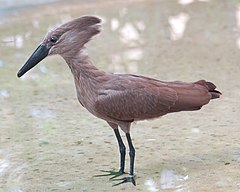Warugi
| Scopidae[1] | |||
| Bonaparte, 1849 | |||
 Przedstawiciel rodziny – waruga (Scopus umbretta) | |||
| Systematyka | |||
| Domena | |||
|---|---|---|---|
| Królestwo | |||
| Typ | |||
| Podtyp | |||
| Gromada | |||
| Podgromada | |||
| Infragromada | |||
| Rząd | |||
| Podrząd | |||
| Rodzina | warugi | ||
| Typ nomenklatoryczny | |||
Scopus umbretta J.F. Gmelin, 1799 | |||
| Synonimy | |||
| Rodzaje | |||
Warugi[8] (Scopidae) – monotypowa rodzina ptaków z rzędu pelikanowych (Pelecaniformes).
Zasięg występowania
Rodzina obejmuje dwa gatunki, w tym jeden współcześnie żyjący, zamieszkujący Afrykę Subsaharyjską, Madagaskar i Półwysep Arabski[9].
Morfologia
Długość ciała 50–56 cm; masa ciała 415–430 g[9].
Systematyka
Etymologia
- Scopus (Scops): gr. σκια skia „cień” (por. σκοπος skopos „obserwator, opiekun”, od σκοπεω skopeō „badać”)[10].
- Umbretta: epitet gatunkowy Scopus umbretta J.F. Gmelin, 1799; fr. nazwa „Ombrette” nadana warudze z powodu jej jednolitego upierzenia w kolorze umbry lub ziemisto-brązowym, od wł. terra d’ombra „umbra”[11]. Nowa nazwa dla Scopus Brisson, 1760.
- Cepphus: gr. κεπφος kepphos „nieznany blady ptak wodny”, później różnie identyfikowany (np. nawałnik, mewa, głuptak, alka), wspomniany przez Arystotelesa, Dionizjusza, Hezychiusza i innych autorów[12]. Gatunek typowy: Cepphus scopus Wagler, 1827 (= Scopus umbretta J.F. Gmelin, 1799).
Podział systematyczny
Do rodziny należy jeden rodzaj z jednym współcześnie żyjącym gatunkiem[8] i jednym wymarłym[13]:
- Scopus umbretta J.F. Gmelin, 1799 – waruga
- Scopus xenopus Olson, 1984 – takson wymarły
Uwagi
- ↑ Niepoprawna późniejsza pisownia Scopus Brisson, 1760.
Przypisy
- ↑ Scopidae, [w:] Integrated Taxonomic Information System [online] (ang.).
- ↑ M.T. Brünnich: Zoologiae fundamenta praelectionibus academicis accommodata. Grunde i dyrelaeren. Hafniae: Apud Frider. Christ. Pelt, 1772, s. 74. (łac.).
- ↑ C.S. Rafinesque: Analyse de la nature, or, Tableau de l’univers et des corps organisés. Palerme: Aux dépens de l’auteur, 1815, s. 71. (fr.).
- ↑ J.G. Wagler: Systema Avium. Cz. 1. Sttutgartiae et Tubingae: mtibus J. G. Gottae, 1827, s. sygn. 101. (łac.).
- ↑ Scopus, [w:] Integrated Taxonomic Information System [online] [dostęp 2014-02-23] (ang.).
- ↑ M.J. Brisson: Ornithologie, ou, Méthode contenant la division des oiseaux en ordres, sections, genres, especes & leurs variétés, a laquelle on a joint une description exacte de chaque espece, avec les citations des auteurs qui en ont traité, les noms quils leur ont donnés, ceux que leur ont donnés les différentes nations, & les noms vulgaires. T. 1. Parisiis: Ad Ripam Augustinorum, apud Cl. Joannem-Baptistam Bauche, bibliopolam, ad Insigne S. Genovesae, & S. Joannis in Deserto, 1760, s. 48. (fr. • łac.).
- ↑ M.J. Brisson: Ornithologie, ou, Méthode contenant la division des oiseaux en ordres, sections, genres, especes & leurs variétés, a laquelle on a joint une description exacte de chaque espece, avec les citations des auteurs qui en ont traité, les noms quils leur ont donnés, ceux que leur ont donnés les différentes nations, & les noms vulgaires. T. 5. Parisiis: Ad Ripam Augustinorum, apud Cl. Joannem-Baptistam Bauche, bibliopolam, ad Insigne S. Genovesae, & S. Joannis in Deserto, 1760, s. 503. (fr. • łac.).
- ↑ a b Systematyka i nazwy polskie za: P. Mielczarek & M. Kuziemko: Rodzina: Scopidae Bonaparte, 1849 - warugi - Hammerkop (Wersja: 2021-01-16). [w:] Kompletna lista ptaków świata [on-line]. Instytut Nauk o Środowisku Uniwersytetu Jagiellońskiego. [dostęp 2022-01-31].
- ↑ a b D.W. Winkler, S.M. Billerman & I.J. Lovette: Hamerkop (Scopidae), version 1.0. W: S.M. Billerman, B.K. Keeney, P.G. Rodewald & T.S. Schulenberg (red.): Birds of the World. Ithaca, NY: Cornell Lab of Ornithology, 2020. DOI: 10.2173/bow.scopid1.01. [dostęp 2020-05-24]. (ang.).

- ↑ Scopus, [w:] The Key to Scientific Names, J.A. Jobling (red.), [w:] Birds of the World, S.M. Billerman et al. (red.), Cornell Lab of Ornithology, Ithaca [dostęp 2022-01-31] (ang.).
- ↑ Umbretta, [w:] The Key to Scientific Names, J.A. Jobling (red.), [w:] Birds of the World, S.M. Billerman et al. (red.), Cornell Lab of Ornithology, Ithaca [dostęp 2022-01-31] (ang.).
- ↑ Cepphus, [w:] The Key to Scientific Names, J.A. Jobling (red.), [w:] Birds of the World, S.M. Billerman et al. (red.), Cornell Lab of Ornithology, Ithaca [dostęp 2022-01-31] (ang.).
- ↑ S.L. Olson. A Hamerkop from the early pliocene of South Africa (Aves: Scopidae). „Proceedings of the Biological Society of Washington”. 97 (4), s. 736–740, 1984. (ang.).
Media użyte na tej stronie
Autor: Jakob Voß, influenced by original art designed at PLoS, modified by Wikipedia users Nina and Beao, Licencja: CC0
Closed Access logo, derived from PLoS Open Access logo. Alternative version.
Autor: (of code) -xfi-, Licencja: CC BY-SA 3.0
The Wikispecies logo created by Zephram Stark based on a concept design by Jeremykemp.
Autor: Photo by and (C)2007 Derek Ramsey (Ram-Man), Licencja: CC BY-SA 2.5
A photograph of Hammerkopen (Scopus umbretta en ). Photo taken at the National Aviary.
| |||


